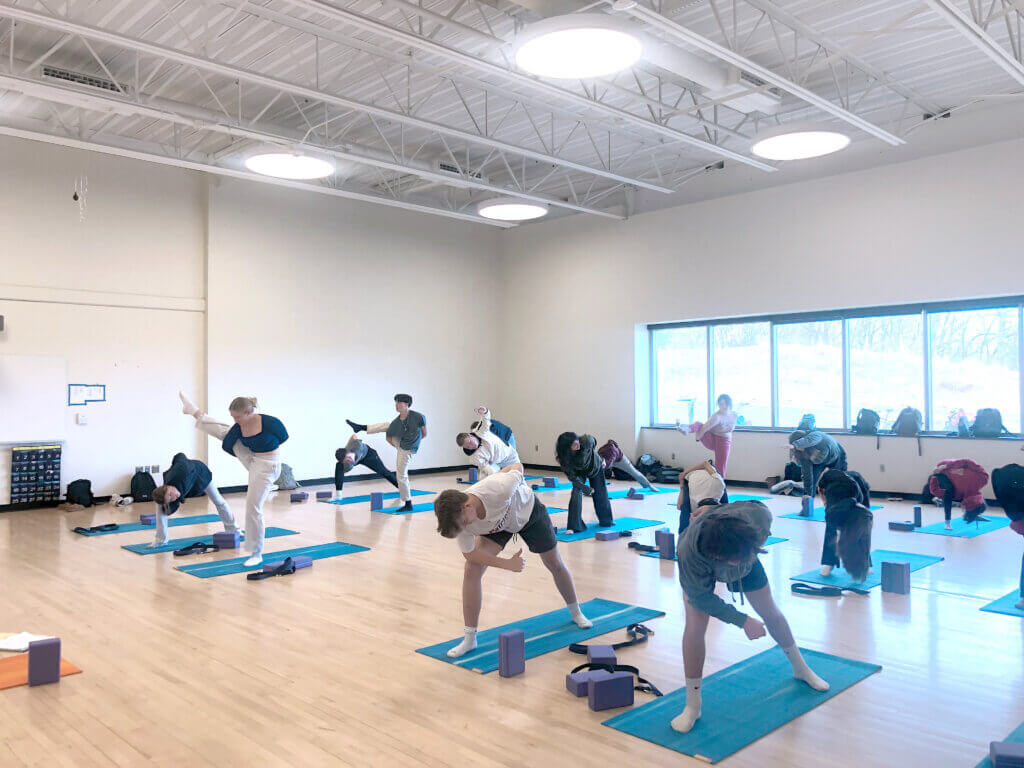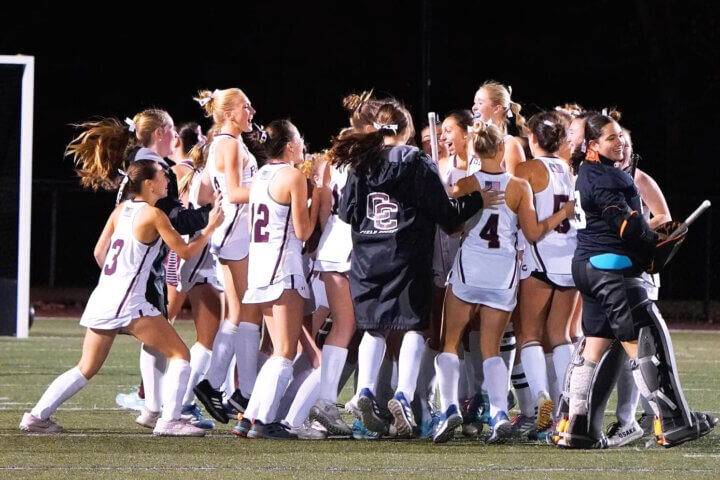By Beth Herman
Concord-Carlisle High School junior Isabella Marx, 17, wishes yoga classes could last longer.
Soccer team member Jameson “Jamo” Velez, also 17, uses yoga the same way he knows Tom Brady and Gronk do: To improve flexibility and overall athletic ability. He finds a direct correlation between the benefits of yoga — including better focus and concentration — and grade improvement.
“There’s no scientific evidence out there,” he says, “but it wouldn’t be a stretch to say it did that for me.”
Marx and Velez are among 80 juniors participating in a CCHS yoga program meeting twice a week through the end of the school year. Developed 20 years ago by health and fitness teacher Nancy Slocum, a yoga curriculum where outcomes reach beyond the physical practice continues to attract juniors who come away with much more than they anticipated.
Program genesis

“I’d always been an athlete, playing soccer at a very high level through Division 1 College at national championships,” Slocum says of her path to yoga. She also played semi-professional soccer as an adult, the highest level available at the time.
“All I knew in terms of my physical pursuits was hard-core athletics. There was nothing wrong with it, but I also kept hearing about yoga,” she recalls. She began wondering about integrating more balance into her regimen.
Unfortunately, her first yoga class turned out to be too “non-vigorous,” an experience she shares with her students.
“There’s not one monolithic yoga,” she tells them, with classes evolving into different styles and approaches as the weeks progress. “While the postures may be the same, the experience may be quite different,” Slocum says.
How it works
Starting slowly, students undergo a flexibility assessment, followed by a Hatha yoga unit with mostly gentle postures. Those include cat/cow, child’s pose, and pigeon. More challenging postures, such as eagle and dancer’s pose, are interspersed.
“We do the same things in health and fitness classes for such a long time,” says Sophie Mahler, 17, whose yoga appreciation is evident in how she speaks of her time in class. “Having yoga here is a nice change of pace.”
“At any level, yoga requires a certain discipline and a certain focus,” Slocum says. “I have expectations of my students.”
Velez agrees, adding, “The environment that Ms. Slocum creates for everyone is something special. It’s relaxing, comfortable, and the yoga calms you down as opposed to gym class where you get more rowdy. It’s good to be able to cool your stress.”
Spending much time in CCHS theater productions, Emma Rowland, 16, also concurs. “High school can be an overwhelming time for students. For me, that was definitely the case. It’s hard to find time for myself and just breathe. Yoga is built into the day, which helps a lot.”

Ramping it up
Following February break, the intensity level increases with Ashtanga yoga. Sun salutations A and B, and a vinyasa flow with more challenging postures, among them headstand, are introduced. The strenuous bird of paradise is a favorite of Isabella Marx’s for its “twisty” component, also embraced by Amelia McDade, 16.
A dancer since age two, McDade finds yoga helps with her balance and flexibility.
“I maintain a rigorous dance schedule outside of school,” she says. “Having yoga during the school day, especially before a test, helps relieve anxiety and stress.”
Merits of meditation
Wellness practices such as meditation, breath work for which students can download apps as tools, progressive muscle relaxation, gratitude practice, and mindfulness are introduced as the class progresses.
According to Slocum, these deepen the practice along with yoga sequences that address specific needs, among them stress reduction, depression, insomnia, anxiety, and improving athletic performance. At this point meditation is also encouraged, using apps to guide.
With the value of meditation lost on some, Slocum shares with her students the story of Dorchester resident George Mumford, author of “The Mindful Athlete: Secrets to Pure Performance.”
A star basketball player at UMass Amherst in the late 1970s, Mumford’s roommate was none other than Julius “Dr. J.” Irving, but a career-ending injury steered Mumford to heroin.
“Part of his journey to sobriety was meditation,” Slocum says. “He works with athletes at Boston University, but is most famously known for his affiliation with former champion Chicago Bulls Coach Phil Jackson and the LA Lakers.
“You never know what resonates with the students. I try to plant seeds that may grow later in their lives.”

Less and more
Having studied with renowned yoga experts including Rodney Yee, Ana Forrest, and Shiva Rea, Slocum reinforces the benefits of yoga that occur off the mat as well, all as a result of a dedicated practice.
“As I practiced yoga more and more, I noticed I was less reactive, more present, more able to deal with all the ups and downs — the vicissitudes of life as they came,” she says. “I was able to meet them with more equanimity and grace. Who wouldn’t want that?”
Home stretch
Toward the end of the school year, an assignment tailored to each student’s preferences offers options including a field trip to a hot yoga studio, a trip to a studio to practice yoga or meditation independently, a home yoga practice or other wellness practice for three weeks, or writing a two-paragraph paper.
Slocum provides resources to support students in their efforts, as well as asking them to keep a home gratitude journal. Students also complete a post-test and compare their scores to their baseline to gauge improved flexibility.
“It’s a delight to see the lightbulb go off when students recognize the impact that consistent yoga practice can have on their fitness, as well as their mental health,” Slocum says.






